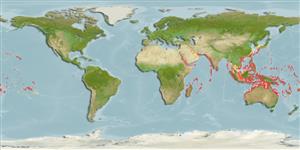Common names from other countries
分類 / Names
共通名の | 類義語 | Catalog of Fishes(部類, 種) | ITIS | CoL | WoRMS | Cloffa
Environment: milieu / climate zone / depth range / distribution range
生態学
海 関連する礁; 深さの範囲 0 - 40 m (Ref. 9813), usually 1 - 30 m (Ref. 27115). Tropical; 25°C - 29°C (Ref. 27115); 30°N - 30°S, 32°E - 128°W
Indo-Pacific: Red Sea and East Africa to Pitcairn. Often the only siganid present on remote islands like Pitcairn, Rapa and Line.
Length at first maturity / サイズ / 重さ / 年齢
Maturity: Lm ?, range 20 - ? cm
Max length : 40.0 cm TL オス/雌雄の選別がない; (Ref. 9813); common length : 25.0 cm TL オス/雌雄の選別がない; (Ref. 9813)
背面の脊椎 (合計) : 13; 背鰭 (合計) : 10; 肛門の骨: 7; 臀鰭: 9; 脊つい: 13. This species is distinguished by the following characters: juveniles and adults with body oval and compressed, slender, fusiform, greatest body depth 2.4-3 in SL; anterior nostril with a long flap reaching to or past posterior nostril; last dorsal-fin spine very short, 2.6-3.5 times in longest dorsal-fin spine; last anal-fin spine shortest, 2.1-3.1 times in longest (second or third) anal-fin spine; caudal fin deeply forked. Colour of body blue or greyish above, silvery below; variations in markings (spots, curved lines); head and trunk usually covered with small yellow spots, bars, and commas, much larger than interspaces and quarter to 1/2 size of pupil; spots usually joining to form horizontal wavy lines, particularly on lower sides; yellow pectoral-fin axil, usually yellow stripes along base of dorsal fin and a dark brown bar immediately posterior to the upper opercular margin; colours fade rapidly at death so that head and trunk may be solid brown (Ref. 9813, 90102).
Inhabits coastal and inner reef slopes and lagoons. Usually occurs in large schools that swim fast and well above the substrate, occasionally all diving down to the bottom to feed (Ref. 48637). Juveniles and adults occur in small schools (2-100) around coral reefs, typically in surge zone at reef edge. Juveniles live near the surface in dense aggregations up to several km offshore, migrating to reef flats just prior to metamorphosis. Feeds on algae (Ref. 30573). Juveniles and adults not frequently found in markets; but prejuveniles form a brief but important fishery when migrating on to the reef flat, e.g. combined catch (with Siganus spinus of 16 tonnes in one season in Guam. Prejuveniles eaten fresh, pickled in brine or made into fish paste (Ref. 9813). Consumed as food although it is known to be occasionally poisonous (Ref. 4537). Used in Chinese medicine (Ref. 12166).
Life cycle and mating behavior
Maturities | 繁殖 | Spawnings | Egg(s) | Fecundities | 幼生
Spawn in group (Ref. 240).
Woodland, D.J., 1990. Revision of the fish family Siganidae with descriptions of two new species and comments on distribution and biology. Indo-Pac. Fish. (19):136 p. (Ref. 1419)
CITES (Ref. 128078)
Not Evaluated
Human uses
水産業: 商業; 水族館・水槽: 商業
用具
特記事項
XMLをダウンロードして下さい
インターネットの情報源
Estimates based on models
Preferred temperature (Ref.
115969): 24.6 - 29, mean 27.8 (based on 1374 cells).
Phylogenetic diversity index (Ref.
82804): PD
50 = 0.5000 [Uniqueness, from 0.5 = low to 2.0 = high].
Bayesian length-weight: a=0.01413 (0.01133 - 0.01761), b=2.99 (2.94 - 3.04), in cm Total Length, based on LWR estimates for this species (Ref.
93245).
栄養段階 (Ref.
69278): 2.0 ±0.0 se; based on diet studies.
回復力 (Ref.
120179): 高い, 15か月以下の倍増期間の最小個体群 (K=0.75; tm=1).
Fishing Vulnerability (Ref.
59153): Low vulnerability (22 of 100).
